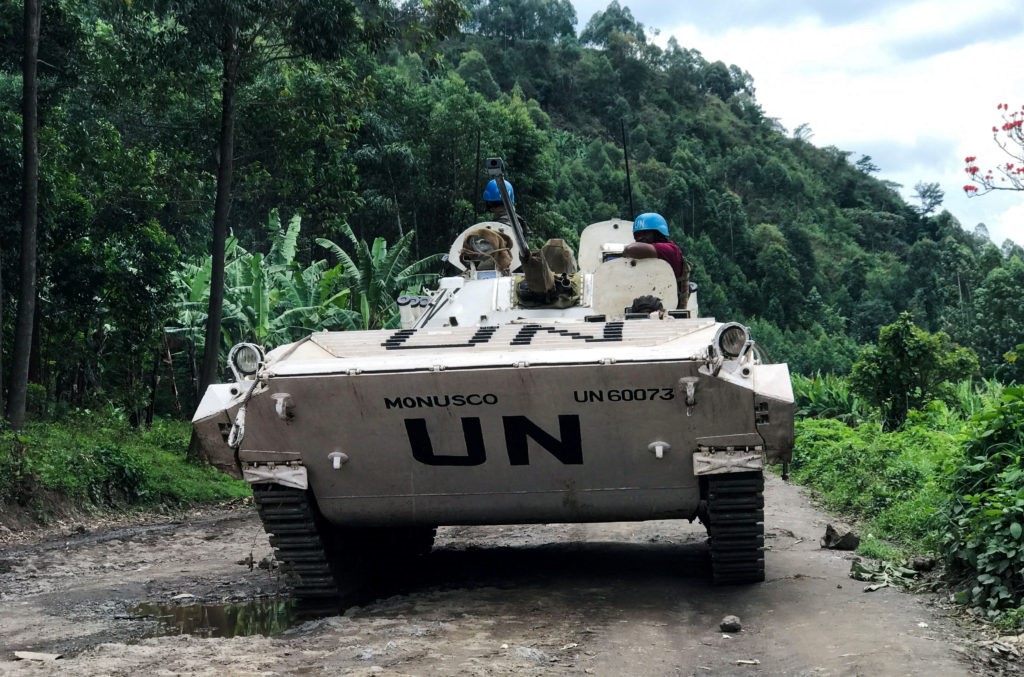Andrew McGregor
From Tips and Trends: The AIS African Security Report
Aberfoyle International Security, April 2015
Despite positive reports from the Ministry of Defence, the Congolese Army’s offensive against Hutu rebels of the Forces Démocratiques de Libération du Rwanda (FDLR) in the eastern Democratic Republic of the Congo (DRC) is yielding little in the way of tangible results.
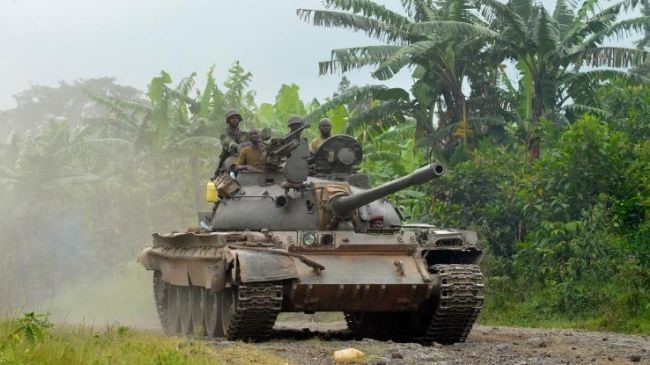 FARDC Tank on Operations in the Eastern Congo
FARDC Tank on Operations in the Eastern Congo
Operation Sokolo II was launched in South Kivu province on February 24, 2015, with the Forces Armées de la République Démocratique du Congo (FARDC) deploying troops into the highlands of South Kivu near Uvira. Further deployments were made in North Kivu two days later. FARDC forces carrying out the offensive consist of three regiments with a total strength of approximately 7500 men. So far, the campaign has resulted in the death of only 13 FDLR insurgents, while a recent FDLR ambush in North Kivu killed ten Congolese soldiers, including two colonels (Reuters, April 8, 2015).
FARDC’s command has reported the capture of several dozen villages, but in many places in North Kivu there is no apparent movement by the Congolese army and unit commanders in the region have not received orders to engage the rebels (Reuters, March 22, 2015). Despite inflicting a small number of casualties on FDLR personnel, all indications suggest that most of the movement has melted into the region’s dense forests to outwait the offensive, knowing that FARDC is incapable of a prolonged field operation and has failed to arrange for sufficient numbers of troops to occupy those towns taken from the FDLR. Already there are reports that FARDC is forced to withdraw to larger centers at night, leaving FDLR the freedom to resupply themselves by night and remind locals of where true power lies in the region (Reuters, March 22, 2015).
Operation Sokolo II was intended to be a joint effort between FARDC and better equipped UN peacekeepers operating in the Congo, but the DRC government’s insistence that two Congolese generals suspected of various war crimes be included in the operation’s command structure led to a UN decision to withdraw from the offensive.
The FDLR
The FDLR was formed in September 2000 from the remains of earlier Hutu militant movements, including the Interahamwe organization responsible for the 1994 genocide of Rwandan Tutsis and politically moderate Hutus. By this point, twenty years later, few members of the FDLR outside the leadership played any role in the Rwandan genocide. As of December 2009, Major General Sylvestre Mudacumara was the FDLR’s overall military commander. Mudacumara, who is wanted by the International Criminal Court (ICC) for war crimes, has a rival within the leadership in Victor Byiringiro, who has a greater interest in a political resolution with Rwanda (African Arguments, March 2, 2015).
Based in North Kivu, the FDLR cannot easily be brought to battle – it typically chooses a time and place of its own, prefers guerrilla-style strikes to conventional tactics and is highly integrated with the local population. Congolese Chief of General Staff of the Army, General Didier Etumba, estimates the FDLR’s strength as consisting of a maximum of 1400 fighters (Radio Okapi [Kinshasha], January 29, 2015). A recent report from the Enough Project summed up the strategy used by the FDLR:
The FDLR’s current strategy is consistent with its long-time pattern of responding to military pressure. In this pattern, the group promises to disarm and reiterates its political aspirations for recognition as a Rwandan opposition group. The FDLR then uses any reprieve to regroup by building military alliances and increasing economic activity and recruitment. [1]
The FDLR has been relatively inactive in the last year, though keeping a low profile might be part of an effort to avoid the fate of the rebel M-23 organization (a.k.a. the Revolutionary Army of the Congo), which was eliminated by joint FARDC-MONUSCO operation in November 2013. Under an agreement supervised by regional organizations (including the International Conference for the Great Lakes Region and the Community of States of Southern Africa), the FDLR had pledged to conduct a voluntary demobilization and disarmament by January 2, 2015, but the small number of old and sick men who surrendered and the insignificant number of weapons that came with them was judged insufficient to mark compliance, thus opening the way for offensive operations against the remainder of the movement.
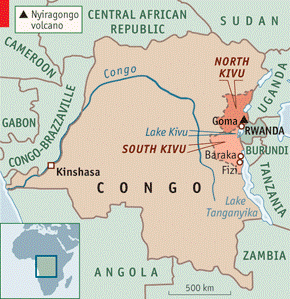 The Kivu region is rich in gold and minerals used in consumer electronics such as wolframite, coltan and cassiterite, though the 2012 implementation of the U.S. Dodd-Frank Act has made it more difficult for rebel groups to profit from the sale of the last three minerals (gold is nearly untraceable and finds ready buyers everywhere) (Mail & Guardian [Johannesburg], November 18, 2014). However, like al-Shabaab in Somalia, the FDLR has turned to the environmentally harmful but lucrative charcoal trade as its greatest source of financing.
The Kivu region is rich in gold and minerals used in consumer electronics such as wolframite, coltan and cassiterite, though the 2012 implementation of the U.S. Dodd-Frank Act has made it more difficult for rebel groups to profit from the sale of the last three minerals (gold is nearly untraceable and finds ready buyers everywhere) (Mail & Guardian [Johannesburg], November 18, 2014). However, like al-Shabaab in Somalia, the FDLR has turned to the environmentally harmful but lucrative charcoal trade as its greatest source of financing.
In the midst of the offensive, Major Zitunga Seraphin, the FDLR’s spokesman for international affairs, told a gathering of journalists that his movement has several demands for the FDLR’s peaceful return to Rwanda. These included justice for all Rwandan citizens and a willingness by the international community to look beyond the crimes of the Hutu to recognize those crimes allegedly committed by Rwanda’s ruling party, the Front Patriotique Rwandais (FPR) (La Rédaction [Kinshasha], March 6, 2015).
MONUSCO
On March 26, the UN Security Council voted to extend the mandate of the Mission de l’Organisation des Nations unies pour la stabilisation en République démocratique du Congo (MONUSCO – United Nations Organization Stabilization Mission in the Democratic Republic of the Congo) to March 31, 2016. The mission began its work in the DRC in 1999.
India is the largest contributor of the 30 nations that have sent troops to the 20,000 man MONUSCO force; other leading contributors include Bangladesh, India, Nepal, Egypt, Pakistan, South Africa, Tanzania and Uruguay. Indian troops have been accused of abuses towards the civilian population as well as conducting illicit commercial exchanges with the FDLR. MONUSCO’s most capable component is its Force Intervention Brigade (FIB), formed by 3,000 elite troops from Tanzania, Malawi and South Africa. It is likely that the FIB’s impending deployment against the FDLR prompted that group’s sham surrender prior to the January 2, 2015 deadline as a means of buying time or discouraging an offensive by UN units. MONUSCO forces in the Congo come under the military command of Brazilian General Carlos Alberto dos Santo Cruz.
UN support for a successful operation is indispensable to the logistics and transport-challenged FARDC forces, as is MONUSCO’s ability to provide surveillance from drones and tactical support from South African Rooivalk attack helicopters. Without such support, even unilateral successes by FARDC will ultimately prove unsustainable in the medium to long-term. The Congolese government has suggested that MONUSCO can run its own operation against the FDLR if it wishes.
FARDC
The Congolese Army consists of 14 brigades of fighters from various pro and anti-government factions that were integrated into the regular army after undoing a process known as brassage (“mixing”).
As in many African countries, the DRC’s regular forces are ill-paid and poorly supplied, with available resources devoted mainly to the Republican Guard (personally loyal to the president) to deter efforts at mounting a military coup d’état. Indiscipline and poor maintenance of arms and equipment are among FARDC’s weaknesses. Logistics is an especially weak component of the FARDC, so the more efficient logistical services of the UN mission will be well missed as the Congolese troops move further into the contested regions of North and South Kivu.
There are many FARDC officers for whom the elimination of the FDLR would mark the end of a profitable collaboration based on poaching, ivory, timber, cannabis (chanvre) and the illegal extraction of gold and other minerals from the Kivu region. Arms and intelligence have in turn flowed from FARDC to the Hutu rebels. According to a MONUSCO report to UN headquarters in New York, the FDLR makes over $70 million annually by doing business with FARDC commanders and implementing illegal taxation. According to the report, the wives of senior FARDC officers acted as trading agents, while their husbands handled the transport of goods in and out of the region (News of Rwanda [Kigali], August 28, 2014; Mail & Guardian [Johannesburg], November 18, 2014). It should be noted that the contacts that ultimately led to such collaboration were forged when the weak Congolese Army was compelled to seek allies in the border region in the face of repeated Rwandan incursions
Collaboration with the FDLR and other rebel movements in the Kivu region goes to the highest ranks of the Congolese Army. Major General Gabriel Amisi Kumba (a.k.a. Tango-Four) recently returned to duty after serving a two-year suspension that followed charges he was selling arms to militant groups in the eastern DRC (Radio Okapi [Kinshasha], August 6, 2014). General Amisi’s rehabilitation has taken place despite further charges that he oversaw the Kinsangani massacre of 2002 and later withdrew a superior FARDC force from the eastern city of Goma in November 2012, allowing the much smaller rebel M-23 movement to take the strategic city without a fight. [2]
Much of the military’s poor performance in northeast Congo to date has been due to the failure of officials in Kinshasha to see that the troops are paid on a regular basis. In 2009, the Rwandan military cooperated with FARDC in an offensive targeting the FDLR inside the Congo. Operation Umoja Wetu (“Our Unity”) was judged a partial success, but left 900,000 people displaced and 1,000 dead. According to Zeno Mutimara, the chairman of the Rwandan Standing Committee on Foreign Affairs, MONUSCO has done nothing since it arrived in the DRC. Mutimara suggested regional military cooperation (as in 2009) would produce better results than reliance on international peacekeepers: “Umoja Wetu is better than the idea that Monusco will do anything. The biggest threat of the FDLR is the spread of genocide ideology; we have to deal with that, we should take responsibility for our own issues” (New Times [Kigali], March 28, 2015).
Operation Sokolo II
Regarding the contentious participation of Congolese Generals Bruno Mandevu and Sikabwe Fall in the current operation, a UN spokesman maintained “the clear point is that in accordance with our human rights due diligence policy, we cannot extend the support if we believe that support will contribute to a course of action in which human rights will be violated” (Inner City Press, March 20, 2015). Nonetheless, despite allegations of war crimes, the two generals were given exemptions to the policy during earlier operations against the Lord’s Resistance Army (LRA). DRC officials maintain that they are not aware of human rights violations by the two generals and have not received documentation of such violations from the UN, even though the UN insists the exemptions could not be renewed due to the failure of Congolese authorities to investigate the allegations (Medafricatimes.com, February 24, 2015; Reuters, March 26, 2015). The allegations include crimes such as rape and summary executions. After the UN withdrew its support for the operation, DRC government spokesmen maintained that it had only chosen its best officers to lead the operation against the FDLR (BBC, March 11, 2015). DRC Information Minister Lambert Mende recently characterized the UN’s decision to withhold support as an “attempt to transform our country into a colony” (VOA, March 30, 2015).
Kinshasha’s attitude on the matter suggests a provocative intent; the Kabila government is seeking a cut of 6,000 troops from the 20,000 man force, effective immediately, followed by a complete withdrawal in the near future, possibly before Kabila seeks a third (and so far unconstitutional) presidential term in elections scheduled for November 2016. The UN Security Council responded on March 26 by agreeing to cut 2,000 troops from the force while renewing MONUSCO’s mandate to March 2016. Despite the lackluster performance of FARDC, the DRC’s Foreign Minister Raymond Tshibanda insists that his nation is ready to take “full responsibility for its own security” (AFP, March 26, 2015).
While the Tutsi-dominated Rwandan government appears determined to eliminate the threat from unreformed genocidaires, the presence of the FDLR and similar Hutu formations across the border justifies the ongoing political domination of Rwanda by its Tutsi minority (15% of the population) and the government’s use of anti-genocide laws to suppress dissent. Maintaining the status quo also prevents or at least postpones any power-sharing initiatives designed to re-integrate the Hutu refugee community living in the DRC. The continued existence of internal enemies like the FDLR provides Kinshasha a useful excuse for its mismanagement of the economy and the evaporation of state revenues by a deeply corrupt regime, though it also invites occasional sovereignty-threatening incursions by foreign militaries, especially that of Rwanda. In the meantime, Rwanda’s justice system has been aggressively pursuing prosecutions against dozens of individuals accused of facilitating the importation of arms into Rwanda for use by the FDLR, with sentences ranging from 10 years to life (Reuters, March 13, 2015).
FDLR rebels were spotted moving through South Kivu’s Itombwe forest on March 16, 2015 (Radio Okapi [Kinshasha], March 17, 2015). Elsewhere, FARDC has reported seizing a FDLR base in Virunga National Park (Medafricatimes, March 10), an environmentally important region of 7800 square kilometers that has suffered greatly from becoming a refuge for all manner of regional militant groups. Large swathes of the park’s forest disappear every day as militants turn wood to charcoal for sale in nearby markets.
The light resistance encountered by FARDC, its own minimal casualties, the relatively low number of civilians displaced by the current operation and FARDC’s apparent inability to draw the enemy to battle or eliminate or capture any of its command structure suggests that Operation Sokola II may be little more than a politically inspired exercise designed to demonstrate the DRC’s ability to mount a counter-insurgency operation on its own and thus encourage greater and faster drawdowns of MONUSCO personnel. The lack of resistance may indicate that the FDLR understands the operation’s sham nature, and thus merely has to wait it out before re-assuming control of the region and resuming the commercial operations that support it (likely including those carried out in cooperation with FARDC). Unfortunately, the reoccupation of villages now in the hand of FARDC will prove to be a disaster for their residents, who will inevitably be accused of cooperation with government forces regardless of their innocence.
Projections
Without UN support, there is a certain inevitability regarding the ultimate failure of FARDC’s campaign against deeply-rooted Hutu militants, though there are a number of possible scenarios:
- The FDLR may be counted upon to do their best to avoid battle at this time. Kinshasha’s expectations of an early and complete withdrawal of UN forces works in the FDLR’s favor and would significantly reduce the military threat to the movement, which has settled somewhat comfortably in the North and South Kivu regions. Remaining in Kivu is a positive alternative to possible repercussions if members of the movement are expelled to Rwanda.
- Despite best intentions on the part of both FARDC and the FDLR, there is always a significant danger of escalation whenever two bodies of undisciplined and heavily armed troops are operating in close proximity. Should Sokola II turn into a real battle with units of the FDLR or any of the other militant groups operating in the same region, there is the very real possibility of FARDC being embarrassed in the field through loss of ground and/or heavy casualties. If FARDC commanders conclude such losses are the result of insufficient support from the Kabila government, they might turn against Kabila, or at the very least oppose his future presidential aspirations.
- While the UN has said it will remain in the DRC until successful operations have lowered the threat level to civilian populations, there may be those in the UN and its financial backers that will welcome the apparent snub from Kinshasha as proof there is little point in continuing to maintain the expensive peacekeeping mission in the Congo, currently the world’s largest.
Notes
- “How to Dismantle a Deadly Militia: Seven non-military tactics to help end the FDLR threat in the Congo,” The Enough Project, November 2014, http://www.enoughproject.org/files/FDLRReport-HowToDismantleADeadlyMilitia-EnoughProject-Nov2014.pdf
- Jean-Jacques Wondo Omanyundu: “Who’s who: Le Général Amisi ‘Tango Four,’ le boucher de l’Est du Congo,” Desc-Wondo, October 3, 2014, http://desc-wondo.org/whos-who-le-general-amisi-tango-four-le-boucher-du-kivu-jj-wondo/
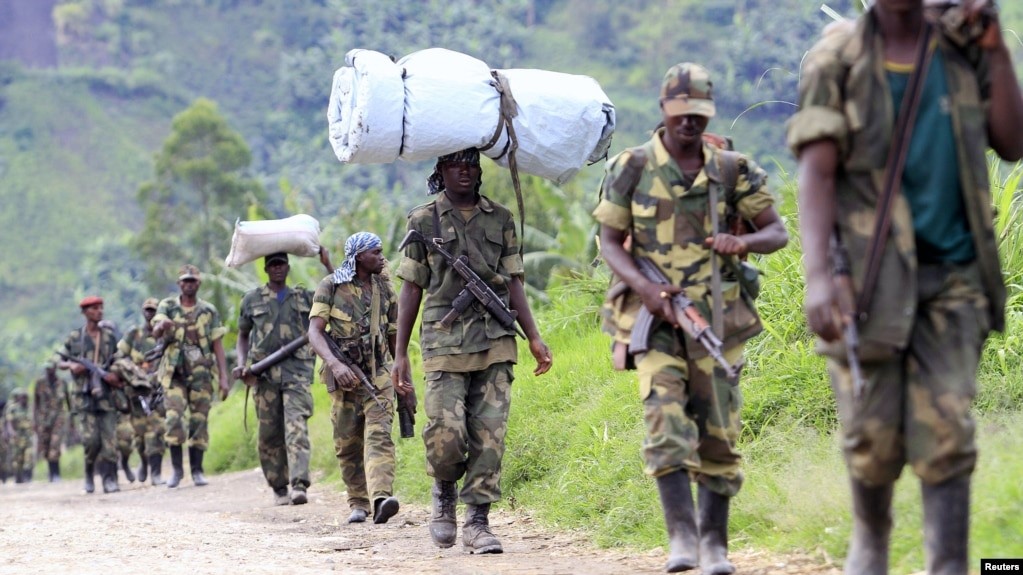 M23 Troops Advance in Nord Kivu (VOA)
M23 Troops Advance in Nord Kivu (VOA)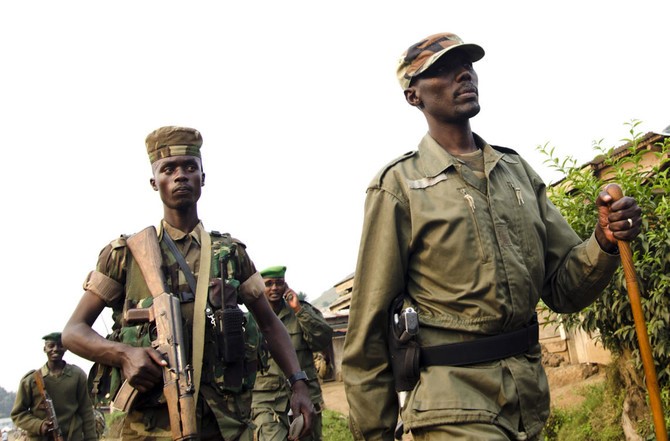 General Sultani Emmanuel Makenga (right) (Arab News)
General Sultani Emmanuel Makenga (right) (Arab News)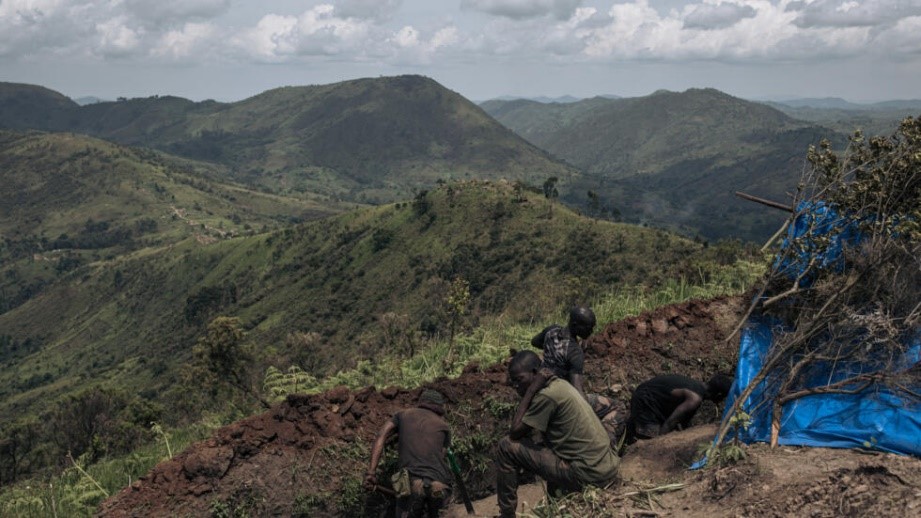 FARDC Defensive Position (AFP)
FARDC Defensive Position (AFP)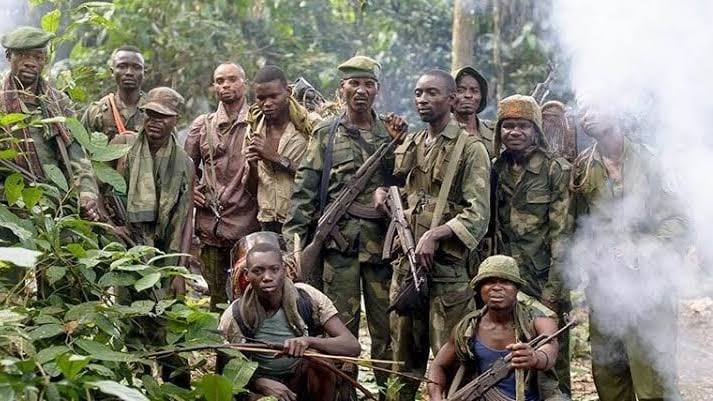 Wazalendo Mayi Mayi (Congo Indépendant)
Wazalendo Mayi Mayi (Congo Indépendant)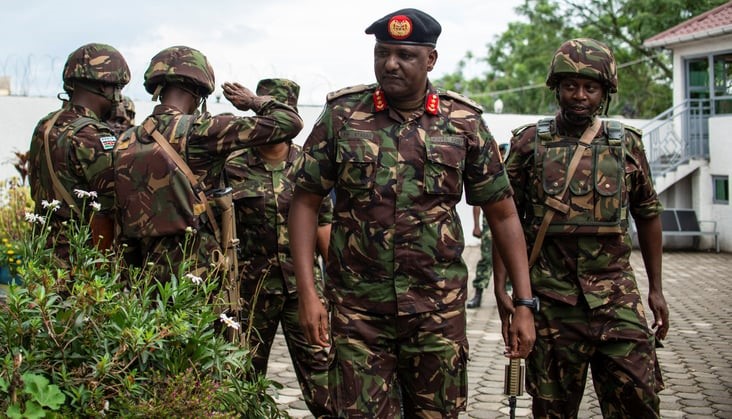 EACRF Commander General Jeff Nyaga
EACRF Commander General Jeff Nyaga
